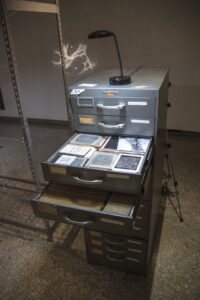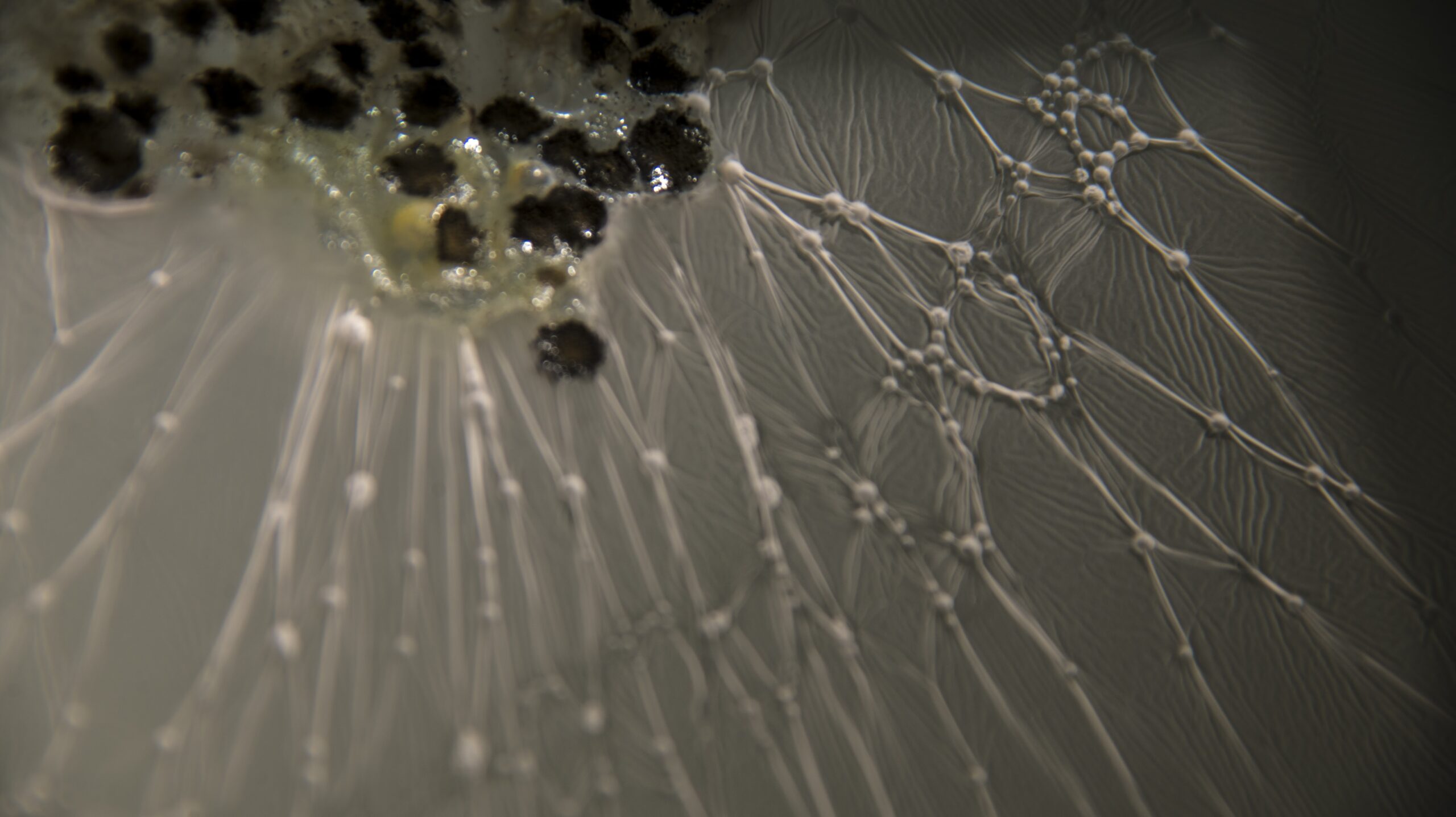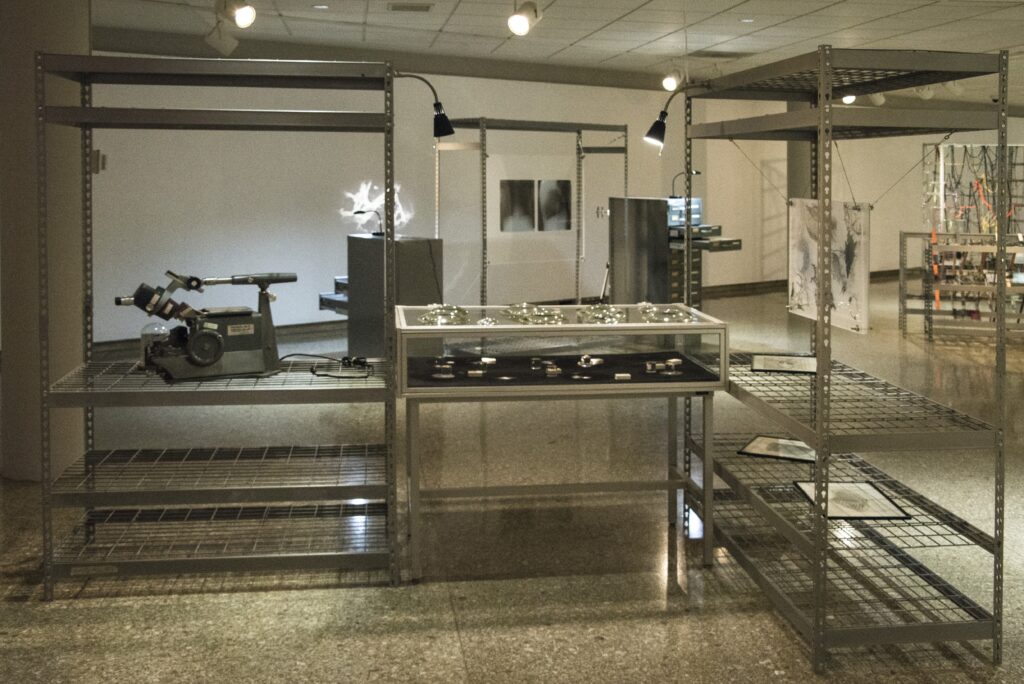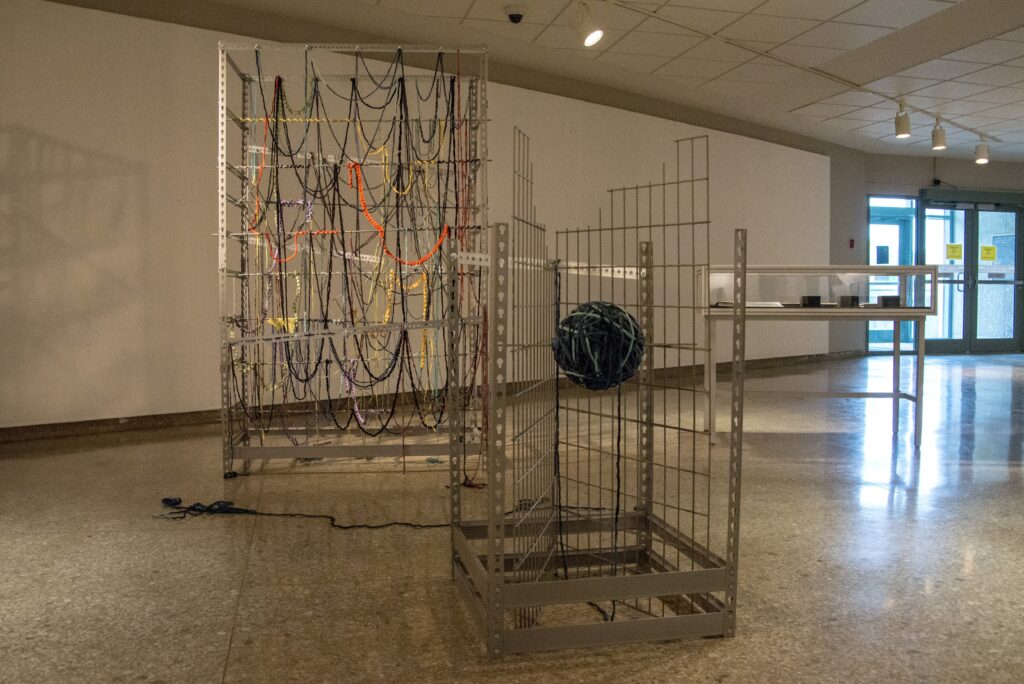There is a hum that accompanies the current exhibition, The Glass Knife, by Stephen Bradley and Kathy Marmor in the Albin O. Kuhn Library Gallery. The installation is structured by the artists to illuminate Keith Porter’s life-long relationship with the micro world of cells, integrating select elements from Porter’s archive within a series of sculptures that allude to his scientific laboratory setting. Both visually and aurally, these works build a sensory experience of discovery as homage to a creative life in science.
“With The Glass Knife, Bradley and Marmor propose a model of imagination that embraces a vision mediated by technology that extends our seeing,” says Emily Hauver, curator of the library gallery exhibitions. “The artists as curators offer metaphoric insight into Porter’s scientific inquiry made possible with his groundbreaking use of the electron microscope that changed the world of cellular science.”
Entering the installation viewers find several workstations, each uniquely presenting a way through rather than a mere reflection of Porter’s working methods and invention. In some, actual artifacts — specimens, images, illustrations, and tools — are embedded within these works alongside the studied re-imaging of the artists.
Porter was the chair of biological sciences at UMBC from 1984 to 1988; today the university’s Keith R. Porter Core Imaging Facility is dedicated to him. He was one of the first scientists to study whole cells and the first to make photographs of tissue cells with the aid of an electron microscope. At the Rockefeller Institute in the 1940s, he produced the first image of an intact cell, made possible by his development of an innovative slicing technique and specimen preparation for viewing and photographing with the electron microscope. The exhibition title “The Glass Knife” refers to the sharp wedge-shaped glass tool he invented.
“It must be evident by now to even the most confirmed skeptic,” Porter said in 1956, “that electron microscopy is destined to have a profound influence on the future development of biology and related sciences.”
His in-depth experience in experimental embryology and histology, along with his talent to interpret these highly magnified images, enabled him to infer the functional activities of cell organelles such as the endoplasmic reticulum (which he discovered and named) and microtubules. Considered among the founders of the modern field of cell biology, Porter was awarded the National Medal of Science in 1977, some referring to him as the “Father of Cell Biology.”
 From a research career spanning more that five decades, he accumulated an extensive archive of research images and personal papers. Planning was already underway for a historically contextualized exhibition, but curators Tom Beck and Emily Hauver’s curatorial vision for the exhibition expanded and led them to invite the artists to work with the archive.
From a research career spanning more that five decades, he accumulated an extensive archive of research images and personal papers. Planning was already underway for a historically contextualized exhibition, but curators Tom Beck and Emily Hauver’s curatorial vision for the exhibition expanded and led them to invite the artists to work with the archive.
Excited to bounce ideas back and forth, Marmor and Bradley’s collaboration began with a list of topics to discuss and consider as they explored the archive: observation, categorization, logic of inquiry, the subjects of inquiry, artifacts, innovation and limitations, bias, and transformation.
Ultimately they came back to the notion of observation, interpretation and resolution as their framing concept for the series of sculptures they made: an immersive experience through Porter’s archive that would reflect his work and also the man himself. The resulting sculptures in the installation incorporate some artifacts from the archive, but it is the artists’ interpretation through their own processes — such as sampling images and illustrations to create their own images and gestures in other materials, and recording sound from tools such as an operational electromagnetic electron microscope to create sound elements -— that heighten the experience of discovery in the exhibition.
They selected a mutable metal shelving system as the support structure for many of the sculptures, finding the material worked formally as a reference for the lab setting they intended to invoke with formal qualities that mimic cell structure and their lattice and scaffolding organization.
Marmor says the exhibition is “a tribute to Porter’s creativity” and Bradley chimes in, adding “and persistence.” He is referring to evidence in the archive that Porter would re-image a cell over and over in an effort to see it more clearly, to push as far as he could to “see.” Both relate as artists to this extended process of repetition and adaption that they saw in Porter’s imaging work and the desire for more and clearer images.
Marmor also calls aspects of her work in the exhibition a “tip of the hat to the women” that worked with Porter. She found examples of their contributions in the archive, including the illustration of the microtrabeculae by Catherine A Verhulst in the exhibition and a photograph of Dr. Mary A Bonneville, Porter’s colleague at University of Colorado, Boulder who operated the electron microscope.
Both artists, says Marmor, wanted to offer a historical glimpse into the “situation of his life, a sense of the man…a guy of the 1950s.” One sculpture includes an x-ray of Porter’s lungs showing the damage from tuberculosis he suffered in the 1940s. In another, a personal letter offers rare insight into the life of a renowned scientist.
Also on view is a complementary exhibition of Life magazines, designed by curator Emily Hauver, illustrating achievement in the sciences in the mid-20th Century. The display contextualizes the era Porter worked in and illustrates the important role scientific imaging was playing is shaping culture around scientific discovery.
The exhibition runs through June 30 in the Albin O. Kuhn Library Gallery. Gallery hours are Monday–Friday: 10:00–4:30 p.m., and in June open on Sunday: 12:00 p.m.–5:00 p.m.
The Glass Knife is part of SEEING SCIENCE a year long project connecting photography, science and visual culture online and at UMBC through April 2017.
Installation images by Stephen Bradley
Tags: Biology, Research, VisualArts



